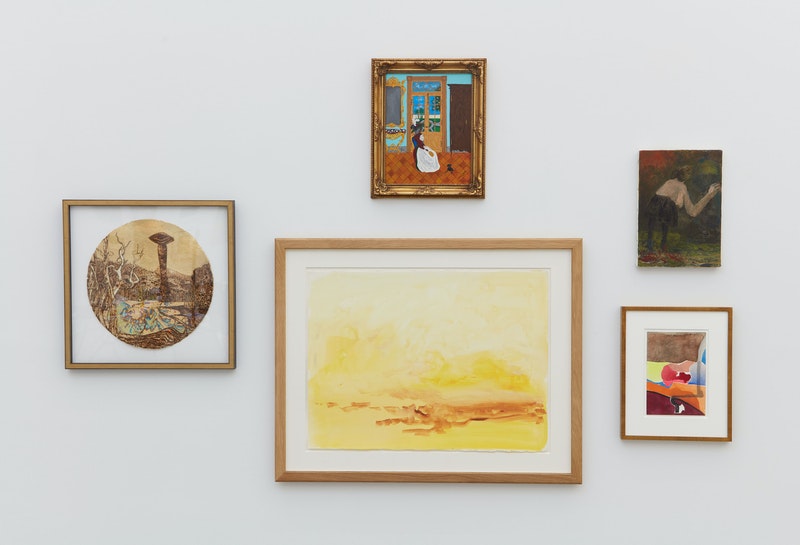September 2021
Download as PDF
View on Brooklyn Rail

Installation view: Get Lifted, Karma, New York, 2021. Courtesy Karma, New York.
In a world that feels more constricted with climate catastrophes and social restrictions, how does one lift? How does one get beyond the borders of a compressed body, a compressed language of the self? How does one begin to transcend to a space of release, to a space of flow, to a space of euphoric joy? By orienting us toward gestures of the ecstatic, Hilton Als compels us to feel it in the introspective intimacy and kinetic ease of Sheryl Sutton, captured in profile and mid-movement in Peter Hujar’s photographs; in Brett Goodroad’s sweeping brush strokes of a swimmer embracing a rock amid a vast sea; in Jack Whitten’s gloriously riotous ink, pastel, and glittered abstractions; in the self-possessed gaze of candid photographs of Ntozake Shange and Alice Coltrane; in the saturated bleeds of Louise Fishman’s watercolors; and more. These are versions of excess that reach beyond: some (Sutton, Shange, and Coltrane) present images of people engaged in their own moments of reverie, mobilizing internal strength or exuberance to transcend an ordered world; others (Whitten, Goodroad, and Fishman) manifest material representations and textures of ecstasy, propelling viewers towards their own internal journeys. These varied versions of rapture are united, however, in their mobilization of excess and its politics.
As Gilles Deleuze and Felix Guattari recognized in 1972’s Anti-Oedipus, our bodies and selves are organized, which is to say boundaried, often according to function, norms, and habit. In focusing on ecstasy as expansion, then, Als invites us to contemplate trespass as offering an alternative to the logics of scarcity that dominate our political and psychological landscapes. Ana Mendieta’s Untitled: Silueta Series (1978) offers an exemplar. The 3-minute film shows the outline of a figure burning in a grass field; the controlled burning signifying the ephemerality of life and the potentiality of transformation. In the smoke and flames, Mendieta evokes the power of release and capacity for continuity in a different form. While Mendieta’s play with landscape is explicitly spatial, Glenn Ligon’s Warm Broad Glow (2005)—a black neon sign reading “negrosunshine”—offers a more circuitous and abstract sense of space in the tension between the words negro and sunshine, especially between the darkly painted words and the brightness they emit. There are many worlds and histories that bring these ideas together. Is this an invocation of laborers working in the heat, a demand for Black affective subservience, or a something else—a place whose contours might become possible in a world without white supremacy?
There is also, as Als’s keen curatorial eye notes, just as much politics in practices of excess. We might locate it, for example, in Shange and Coltrane’s everyday movements—made visible, though notably not captured, in two vitrines in the gallery’s smaller second room. Als presents us with images of these women socializing and posing with friends, as well as excerpts of their writings. These are not instruction manuals or portals but examples of the possibility of materializing ecstasy in the more quotidian ways of being while simultaneously asserting a lifestyle of intentional radicality. Shange’s innovative choreopoem, a dramatic form that combines poetry, dance, music, and song, challenges the containment of Western aesthetics while addressing race and racism. Her energetic swoon is further conveyed in the double-exposed swirl of Anthony Barboza’s (1977) portrait. Alice Coltrane wove together mysticism and jazz into groundbreaking compositions while simultaneously dedicating herself to Vedantic spirituality. Her cosmic theorizations are presented in verse and liner notes.
Likewise, the nine digital prints of Senga Nengudi’s “Flying” (1982/2014) series, which show a group in white conducting an unspecified ritual, imagine ecstasy in collectivity and being-together, enactments that exceed the singular. These practices of ecstasy are legible, too, in artistic approaches. Stacy Lynn Waddell’s Untitled (Three Friends Smiling and Striking a Pose) (2021) cloaks a canvas in 24 karat and composition gold leaf so that the painting of friends posing is barely legible. When the light hits right, one can make out the outline of legs and the closeness of the bodies. The duality embedded in this tactic of obfuscation suggests several things—one, that ecstasy needs to be felt, but not rendered transparent and two, that it be celebrated for the revelation that it is.
Mirroring this spectral legibility but through the lens of desire is Jared Buckheister’s Untitled (cowboy weeping) (2017) where delicate lines barely reveal a figure, face obscured, one arm clutching the chest while the other arm braces itself against a tree. A poignant intimacy that carves its own subjective time and space is expressed in Paul Thek’s Untitled (FIREFLY) (1977) as a note to a meaningful other with a ballpoint drawing of a light striating the darkness accompanied by a personal poem: “See the man with the lonely eyes, Take his hand, be surprised.”
Ecstasy is, as José Esteban Muñoz has written, “a request to step out of the here and now of straight time.”1 The queerness of which Muñoz speaks is a horizon, offering a disruption to a current world order while also manifesting an alternative. In assembling multivalent versions of ecstasy, Als invites viewers to feel for the potentiality of these queer worlds that exist alongside the violence of present. If ecstasy brings one outside or thoroughly inside oneself, we can ask what liberation might feel like and how might one get there? The breadth of curation also allows Als to enact the same politics of plenitude that ecstasy elicits—Als does not restrict ecstasy’s contours, but, instead, invites viewers to engage personally, politically, and joyfully.
- José Esteban Muñoz, Cruising Utopia: The Then and There of Queer Futurity (New York: New York University Press, 2009), 187.



